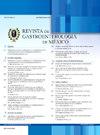Eficacia del uso de polvo hemostático para el manejo endoscópico de la hemorragia digestiva alta de origen tumoral
IF 1.7
Q3 GASTROENTEROLOGY & HEPATOLOGY
引用次数: 0
Abstract
Introduction
Upper gastrointestinal bleeding (UGIB) of neoplastic origin is a rare but life-threatening cause of bleeding. Endoscopic treatment is challenging due to diffuse oozing blood and high rates of rebleeding, despite coagulation and hemoclip use. Hemostatic powders can be an option in those patients. We aimed to determine the initial hemostatic rate and the rebleeding rate at 7 and 30 days, using hemostatic powders in patients with malignant UGIB at a national referral center in Mexico.
Material and methods
A retrospective, observational study was conducted on patients with malignant UGIB treated with hemostatic powder between 2018-2023. Demographic and clinical variables, endoscopic findings, and treatment results were analyzed. A central tendency analysis and the chi-square test were employed.
Results
The study included 54 patients (54.7% were men), with a mean age of 54 years. A total of 40.7% were diagnosed with gastric cancer and presented with an episode of malignant UGIB. Of the endoscopic findings, 52% of patients had active malignant UGIB, most presenting with oozing bleeding (57.4%). EndoClot™ was the main monotherapy employed (81.5%), achieving initial homeostasis in 100% of cases. The rebleeding rate was 22.2% at 7 days and 44.4% at 30 days, with a 30-day accumulated mortality rate of 35.2%.
Conclusions
Malignant UGIB is a potentially life-threatening complication. Hemostatic powder use is highly recommendable due to its efficacy in the immediate control of bleeding. Nevertheless, its effect is temporary, suggesting its use as bridging therapy, facilitating bleeding stabilization and enabling the implementation of definitive hemostatic treatments.
使用止血粉内窥镜管理高肿瘤性消化出血的有效性
肿瘤源性上消化道出血是一种罕见但危及生命的出血原因。尽管使用了凝血和夹血,但由于弥漫性渗血和高再出血率,内镜治疗是具有挑战性的。止血粉是这些患者的一种选择。我们的目的是确定在7天和30天的初始止血率和再出血率,在墨西哥国家转诊中心使用止血粉治疗恶性UGIB患者。材料与方法对2018-2023年使用止血散治疗的恶性UGIB患者进行回顾性观察研究。分析人口统计学和临床变量、内镜检查结果和治疗结果。采用集中趋势分析和卡方检验。结果54例患者(男性54.7%),平均年龄54岁。共有40.7%的患者被诊断为胃癌,并出现恶性UGIB发作。在内镜检查结果中,52%的患者有活动性恶性UGIB,大多数表现为渗出出血(57.4%)。EndoClot™是采用的主要单药治疗(81.5%),100%的病例实现初始稳态。7天再出血率为22.2%,30天再出血率为44.4%,30天累计死亡率为35.2%。结论恶性UGIB是一种危及生命的并发症。止血粉的使用是非常值得推荐的,因为它能立即控制出血。然而,它的效果是暂时的,建议将其用作桥接治疗,促进出血稳定并使最终止血治疗得以实施。
本文章由计算机程序翻译,如有差异,请以英文原文为准。
求助全文
约1分钟内获得全文
求助全文
来源期刊

Revista de Gastroenterologia de Mexico
GASTROENTEROLOGY & HEPATOLOGY-
CiteScore
1.60
自引率
12.50%
发文量
102
审稿时长
12 weeks
期刊介绍:
La Revista de Gastroenterología de México es el órgano oficial de la Asociación Mexicana de Gastroenterología. Sus espacios están abiertos a los miembros de la Asociación como a todo miembro de la comunidad médica que manifieste interés por utilizar este foro para publicar sus trabajos, cumpliendo con las políticas editoriales que a continuación se mencionan. El objetivo principal de la Revista de Gastroenterología de México, es publicar trabajos originales del amplio campo de la gastroenterología, así como proporcionar información actualizada y relevante para el área de la especialidad y áreas afines. Los trabajos científicos incluyen las áreas de Gastroenterología clínica, endoscópica, quirúrgica y pediátrica.
 求助内容:
求助内容: 应助结果提醒方式:
应助结果提醒方式:


